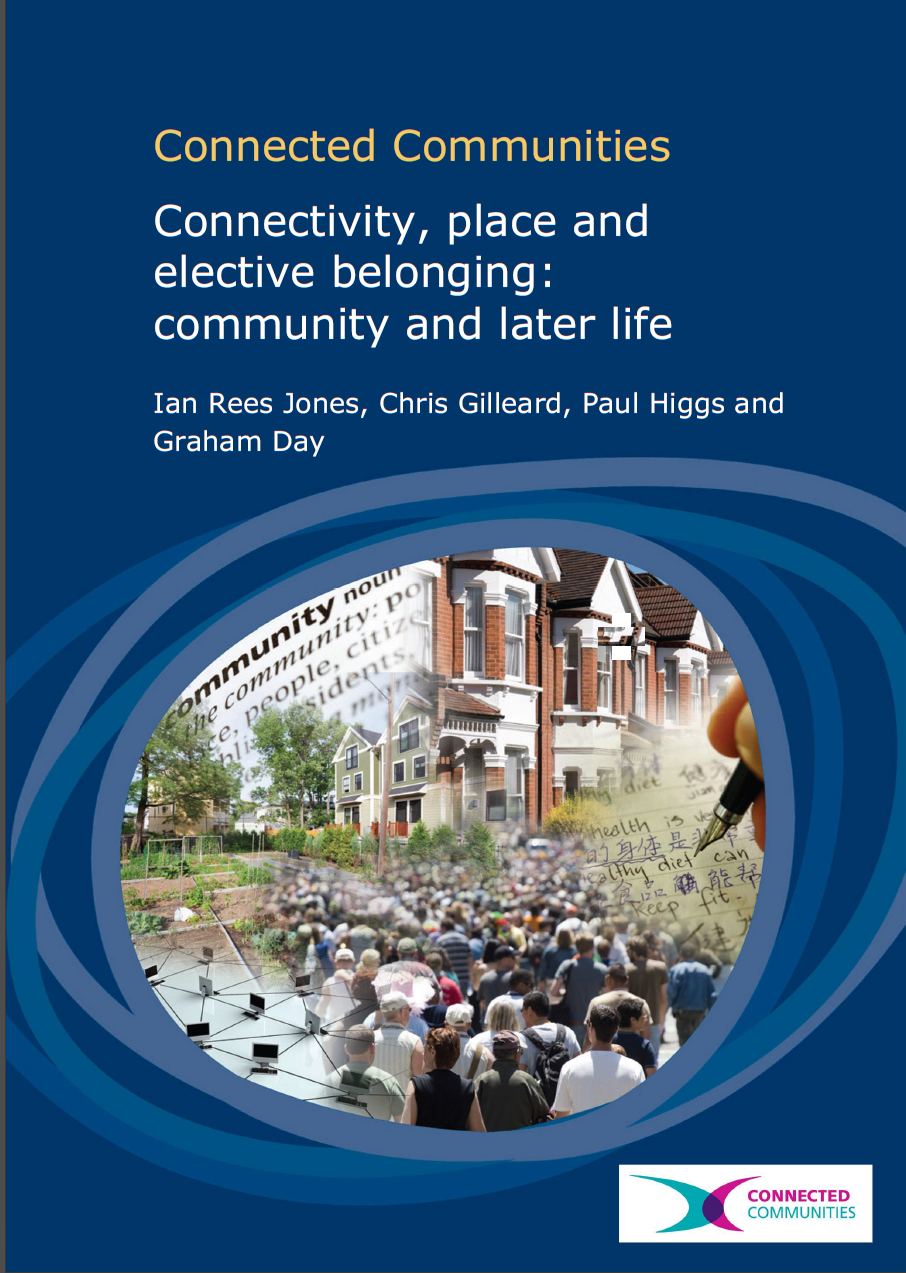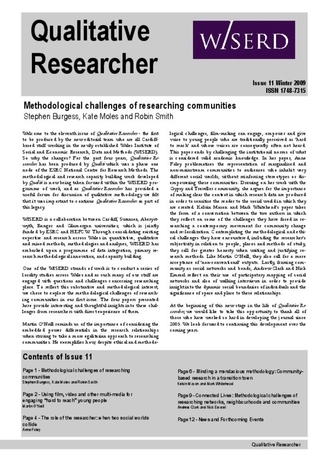Mae'r cynnwys hwn ar gael yn Saesneg yn unig.
Overview
As a part of the development process for the Connected Communities programme, the AHRC supported research reviews in 2011 to address a wide range of underpinning issues. The aim of these reviews was to: stimulate debate and provide some early outputs from the programme; inform future discussions about its shape, focus and priorities; and be of value to researchers undertaking research under the programme in the future. This review addressed ‘Social networks and later life’ and ‘The impact of Information and communication technologies (ICT) on community and older people’.
The aim was to undertake a review of the research literature addressing community, connectivity and later life in two key theme areas:
- A review of the impact of ICT on community and older people focusing on studies of levels of diffusion of ICT in older groups and the positive and negative effects of connectivity for older people and their communities.
- A review of studies of social networks and later life focusing on the relationship between social connectivity and levels of well-being, attachment to place and belonging in the context of migration, ageing in place and retirement to place.
Findings
I: Community, Place and Belonging in Later Life
The roles and experiences of older people in communities has been a focal point for community studies in the past. In the new material circumstances and social relations that have accompanied the economic and technological changes of second modernity, communities of interest become increasingly important. Older communities of propinquity and attachments to locale and place remain; but in different circumstances. For older people these changes throw up contradictions and tensions; as being linked to local communities may have beneficial aspects and be desired but may be associated with being stuck, unchanging and old. For some who have the financial and social capital community may involve active choices; for others it may be part of an experience of isolation and exclusion. There is a considerable literature on ageing and place which highlights important links between the environment, individual characteristics and successful ageing. This has influenced national and international policies with respect to later life. While there is evidence to support associations between place and well-being in later life there is room for caution and researchers have also identified potential drawbacks to ageing in place. There is evidence that ageing is related to a growing sense of attachment to place but the relationship is complex and there are ambiguities and countervailing effects.
Research has shown that civic engagement and social participation is important for well-being in later life and for the development and maintenance of community networks. However, in the main, studies are cross sectional and causality remains unclear. Studies of migration in later life indicate complex patterns of mobility leading to the formation of new forms of social relations, friendships, support, reciprocity and social exchange. The impact of large retirement migration flows on local and transnational community networks, on identity formation and on national welfare services is still not well understood. The research on gender and community indicates important pathways that maintain community cohesion and health but for women there are also potential negative effects. Although most of the literature on community and place and ageing deals with urban environments there is an important and growing literature addressing ageing in rural areas. An important finding is that social changes impacting on rural areas are undermining traditional accounts of community and later life. Policies to address rural poverty and ageing have been criticised for not taking account of the heterogeneity of later life in these areas.
II: Social networks and later life
With its emphasis on the interrelationship between individual and contextual factors over the life course the convoy model provides an important and useful framework for studying social networks among older groups. Research has identified different social network types and these have been found to be good predictors of levels of well-being. Caution is however necessary as these network types may vary cross-nationally and culturally. The quality of social ties and relationships may become more salient in later life. Age is related to network size, structure and density and there is a strong ‘U’ shaped relationship between age and volume of contact among network members (though this is mediated by life events). The research evidence for the relationship between social networks and health is largely cross-sectional and issues of causality, measurement and countervailing effects remain. Overall, research on social connectivity and later life has identified key factors that may influence levels of connectivity but there are a number of contradictions and paradoxes in the literature leading to some debate and controversy. The influence of the increasing engagement of older people with ICT on these debates remains limited.
III: ICT, connectivity and later life
Patterns of ICT adoption and use are rapidly evolving and although there are lower levels of adoption among older people there is evidence that older groups catch up quickly and that there may be generational effects at work. ICT may facilitate the development of aged based communities of interests or intentional communities. The broad evidence of an age based ‘digital divide’ is likely to be a crude division that hides patterns of inequality and diversity among older groups themselves and there is evidence that older people can and wish to become active users of technology. The evidence for the impact of ICT on health and well-being is mixed and there is some evidence that older people may be being treated as passive objects of research. There is a strong case for researching ICT and ageing from the perspectives of the third and fourth ages. While different technologies differ in their immediate benefits, at both individual and community levels, the dangers and risks for older people associated with these technologies remain. These tensions are not fully articulated in the literature.
Symposia:
- Symposium at the annual conference of the British Gerontological Society in July 2011 title ‘Connectivity, place and elective belonging: community and later life’.
- Symposium at the 64th Annual Scientific Meeting of the Gerontological Society of America in November 2011.
Conference papers:
- Jones, I.R. (2011) Community, Connectivity, Mobility and Later Life, The Gerontological Society of America 64th Annual Scientific Meeting, 2011.
- Jones, I.R. (2011) Connectivity, place and elective belonging: community and later life, British Society of Gerontology Annual Conference, 2011.
- Jones, I.R. (2011) The normalization of diversity and later life: consumer society and the normative transformations of ageing in the 21st century, IAGG Annual Conference 2011.
- Jones, I.R. (2011) Theory and Structure in ‘Cultures of Ageing’, ENAS Inaugural Conference, 2011.
- Jones, I.R. (2012) The changing horizons of later life: implications for studies of community and social cohesion, Community, Cohesion and Social Stability: Historical and Contemporary Perspectives, Bangor University.
Book Chapters
- Jones, I.R. and Higgs, P (2013 forthcoming) Class and health inequalities in later life, in Formosa, M. and Higgs, P. (Eds) Social Class in Later Life Power, Identity and Lifestyle, Policy Press.
About Connected Communities
Connected Communities is a cross-Research Council research programme led by the AHRC. The proposed vision for the Programme is “to mobilise the potential for increasingly inter-connected communities to enhance self-reliance, regeneration, sustainability, health & well-being by better connecting research, stakeholders and communities.”
At the core of the Programme is research to understand the changing nature of communities, in their historical and cultural contexts, and the value of communities in sustaining and enhancing our quality of life. This enhanced understanding will also inform the development of more effective community based interventions to address key economic and societal challenges.
Engagement with communities at all stages of the research is a key feature. The programme seeks to connect research expertise and data relevant to communities from across the research base in order to develop a more holistic understanding of community life rather than tackling issues in isolation. The Programme began by supporting over 80 initial development works, scoping studies, reviews and partnership activities. WISERD was involved in three of these projects.





